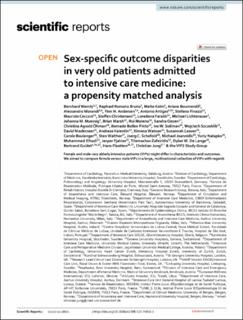| dc.contributor.author | Wernly, Bernhard | |
| dc.contributor.author | Bruno, Raphael Romano | |
| dc.contributor.author | Kelm, Malte | |
| dc.contributor.author | Boumendil, Ariane | |
| dc.contributor.author | Morandi, Alessandro | |
| dc.contributor.author | Andersen, Finn Husøy | |
| dc.contributor.author | Artigas, Antonio | |
| dc.contributor.author | Finazzi, Stefano | |
| dc.contributor.author | Cecconi, Maurizio | |
| dc.contributor.author | Christensen, Steffen | |
| dc.contributor.author | Faraldi, Loredana | |
| dc.contributor.author | Lichtenauer, Michael | |
| dc.contributor.author | Muessig, Johanna M. | |
| dc.contributor.author | Marsh, Brian | |
| dc.contributor.author | Moreno, Rui | |
| dc.contributor.author | Oeyen, Sandra | |
| dc.contributor.author | Öhman, Christina Agwald | |
| dc.contributor.author | Pinto, Bernadro Bollen | |
| dc.contributor.author | Soliman, Ivo W. | |
| dc.contributor.author | Szczeklik, Wojciech | |
| dc.contributor.author | Niederseer, David | |
| dc.contributor.author | Valentin, Andreas | |
| dc.contributor.author | Watson, Ximena | |
| dc.contributor.author | Leaver, Susannah | |
| dc.contributor.author | Boulanger, Carole | |
| dc.contributor.author | Walther, Sten | |
| dc.contributor.author | Schefold, Jörg C. | |
| dc.contributor.author | Joannidis, Michael | |
| dc.contributor.author | Nalapko, Yuriy | |
| dc.contributor.author | Elhadi, Muhammed | |
| dc.contributor.author | Fjølner, Jesper | |
| dc.contributor.author | Zafeiridis, Tilemachos | |
| dc.contributor.author | De Lange, Dylan W. | |
| dc.contributor.author | Guidet, Bertrand | |
| dc.contributor.author | Flaatten, Hans | |
| dc.contributor.author | Jung, Christian | |
| dc.date.accessioned | 2021-05-28T09:11:43Z | |
| dc.date.available | 2021-05-28T09:11:43Z | |
| dc.date.created | 2021-01-19T16:34:33Z | |
| dc.date.issued | 2020 | |
| dc.identifier.issn | 2045-2322 | |
| dc.identifier.uri | https://hdl.handle.net/11250/2756818 | |
| dc.description.abstract | Female and male very elderly intensive patients (VIPs) might differ in characteristics and outcomes. We aimed to compare female versus male VIPs in a large, multinational collective of VIPs with regards to outcome and predictors of mortality. In total, 7555 patients were included in this analysis, 3973 (53%) male and 3582 (47%) female patients. The primary endpoint was 30-day-mortality. Baseline characteristics, data on management and geriatric scores including frailty assessed by Clinical Frailty Scale (CFS) were documented. Two propensity scores (for being male) were obtained for consecutive matching, score 1 for baseline characteristics and score 2 for baseline characteristics and ICU management. Male VIPs were younger (83 ± 5 vs. 84 ± 5; p < 0.001), less often frail (CFS > 4; 38% versus 49%; p < 0.001) but evidenced higher SOFA (7 ± 6 versus 6 ± 6 points; p < 0.001) scores. After propensity score matching, no differences in baseline characteristics could be observed. In the paired analysis, the mortality in male VIPs was higher (mean difference 3.34% 95%CI 0.92–5.76%; p = 0.007) compared to females. In both multivariable logistic regression models correcting for propensity score 1 (aOR 1.15 95%CI 1.03–1.27; p = 0.007) and propensity score 2 (aOR 1.15 95%CI 1.04–1.27; p = 0.007) male sex was independently associated with higher odds for 30-day-mortality. Of note, male gender was not associated with ICU mortality (OR 1.08 95%CI 0.98–1.19; p = 0.14). Outcomes of elderly intensive care patients evidenced independent sex differences. Male sex was associated with adverse 30-day-mortality but not ICU-mortality. Further research to identify potential sex-specific risk factors after ICU discharge is warranted.
Trial registration: NCT03134807 and NCT03370692; Registered on May 1, 2017 https://clinicaltrials.gov/ct2/show/NCT03370692. | en_US |
| dc.language.iso | eng | en_US |
| dc.publisher | Nature Research | en_US |
| dc.rights | Navngivelse 4.0 Internasjonal | * |
| dc.rights.uri | http://creativecommons.org/licenses/by/4.0/deed.no | * |
| dc.title | Sex-specific outcome disparities in very old patients admitted to intensive care medicine: a propensity matched analysis | en_US |
| dc.type | Journal article | en_US |
| dc.type | Peer reviewed | en_US |
| dc.description.version | publishedVersion | en_US |
| dc.rights.holder | Copyright 2020 The Author(s). | en_US |
| dc.source.articlenumber | 18671 | en_US |
| cristin.ispublished | true | |
| cristin.fulltext | original | |
| cristin.qualitycode | 1 | |
| dc.identifier.doi | 10.1038/s41598-020-74910-3 | |
| dc.identifier.cristin | 1874662 | |
| dc.source.journal | Scientific Reports | en_US |
| dc.identifier.citation | Scientific Reports. 2020, 10, 18671 | en_US |
| dc.source.volume | 10 | en_US |

